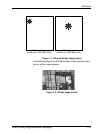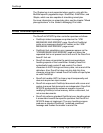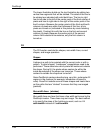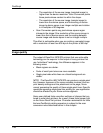
PostScript
1-20 Guide to Using Page Description Languages
(showpage\004) cvn {showpage} def
(sp\004) cvn {sp} def
NOTE: It is not desirable to redefine a legal substring ABC
as some other legal substring XYZ in the illegal token
initialization file. For instance, although
showpage
frequently
is redefined by PostScript code to be sp for brevity, it may
seem to make sense to redefine
sp <control D>
as
showpage. However, if the client application creating the
PostScript defines sp to mean show rather than
showpage
,
then to have
sp <control D>
initialized to mean
showpage
is
an error.
Also, due to case sensitivity, some patterns may have to
appear with the same case variety as in the PostScript jobs to
be processed.
Because there may be an infinite number of character
combinations, the system administrator is encouraged to
redefine only known or suspect problem tokens.
Multiple jobs in one input file
Note that the above control-D handling does not perform true
PostScript job encapsulation. Therefore, the following PostScript
job situations may cause problems. All of these problems are
due to having multiple PostScript jobs in one input file. If
problems occur, break the concatenated masters into separate
input files.
• Because control-Ds are not interpreted as end-of-job (EOJ),
PostScript virtual memory (VM) is not restored before the
next job. This means that the next job environment is not
“clean,” which may or may not cause problems. PostScript
VM may also run out since VM is not restored by control-D.
Note that all Xerox PostScript products do restore VM at the
end of their input file, so single PostScript jobs per input file
are always handled correctly.
• Some of the PostScript jobs execute exitserver, which stays
in effect until EOJ. Because the control-Ds are not interpreted
as EOJ, subsequent non-exitserver job definitions become
permanent, which could consume all of the PostScript VM or
cause other PostScript problems.


















